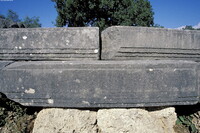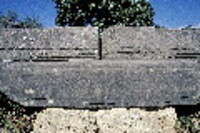| dc.coverage.spatial | Site: Olympia, Peloponnese, Greece | en_US |
| dc.coverage.temporal | ca. 338 BCE (creation) | en_US |
| dc.creator | unknown (Greek (ancient)) | en_US |
| dc.date | -338--330 | en_US |
| dc.date.accessioned | 2013-05-22T19:40:34Z | |
| dc.date.available | 2013-05-22T19:40:34Z | |
| dc.date.issued | -338--330 | en_US |
| dc.identifier | 220977 | en_US |
| dc.identifier.other | archrefid: 695 | en_US |
| dc.identifier.uri | http://hdl.handle.net/1721.3/128901 | |
| dc.description | Detail depicting marble plinth; The Philippeion, an elegant circular peripteral building (diam. 15.24 m) south of the prytaneion, was begun by Philip II of Macedonia after the Battle of Chaironeia (338 BCE) but finished by his son Alexander the Great. It stood on a marble stylobate, mostly preserved, and was surrounded by an Ionic colonnade. Corinthian half-columns were placed at intervals around the interior of the circular cella, at the back of which were five chryselephantine portrait statues by Leochares representing Alexander the Great between his parents and his grandfathers. This type of tholos (circular building), used earlier for worship of the gods, was here employed for the first time for the hero cult of the Macedonian dynasty. Source: Grove Art Online; http://www.groveart.com/ (accessed 11/4/2007) | en_US |
| dc.format.medium | marble | en_US |
| dc.rights | © Scott Gilchrist, Archivision, Inc. | en_US |
| dc.subject | architectural exteriors | en_US |
| dc.subject | rulers and leaders | en_US |
| dc.subject | Alexander, the Great, 356-323 B.C. | en_US |
| dc.subject | Hellenistic | en_US |
| dc.title | Olympia: Philippeion | en_US |
| dc.title.alternative | Philippeion | en_US |
| dc.type | image | en_US |
| dc.rights.access | Licensed for educational and research use by the MIT community only | en_US |
| dc.identifier.vendorcode | 1A3-G-O-6-B4 | en_US |
| vra.culturalContext | Greek (ancient) | en_US |
| vra.technique | construction (assembling) | en_US |
| vra.worktype | temple | en_US |
| vra.worktype | tholos | en_US |
| dc.contributor.display | unknown (Greek (ancient)) | en_US |



